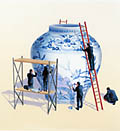 About F&D Subscribe Back Issues Write Us Copyright Information |
From the editor It will soon be four years since the Asian financial crisis began with a run on the Thai baht. The crisis spread rapidly, affecting other financial centers throughout the region, and many observers expressed concern that the systemic impact could be long-lasting. Most of the economies of the region, however, soon staged a remarkable recovery thanks to domestic policies designed to restore financial sector soundness, strong export growth, and effective international support, including large-scale support from the IMF. Nonetheless, recent developments in the international economy have aroused fresh concerns. The severe impact of the financial crisis and continuing challenges are reviewed in the Bulletin section of this issue of Finance & Development. Scott Roger concludes that, although there appears to be little risk a major financial crisis will recur, the Asian economies must press ahead with the reform and restructuring of their financial sectors. Several articles look at different aspects of this topic. William P. Mako describes the ways to promote best practices in corporate restructuring in Asia. Ashoka Mody and Shoko Negishi examine the role of mergers and acquisitions in strengthening foreign direct investment during and after the crisis and their likely impact on long-term productivity. The challenges created by the aging of Japan's population and how to manage them are discussed by Martin Mühleisen and Hamid Faruquee, while Neil Gregory and Stoyan Tenev review ways in which China's fledgling private sector can increase its access to external financing. A little over a year ago, East Timor won self-governing status amid widespread violence and is now receiving considerable international support in its efforts to restructure its economy. Luis M. Valdivieso and Alejandro López-Mejía explain the difficult work of macroeconomic management, while a distinctively East Timorese view of the remaining challenges is provided by José Ramos Horta, 1996 Nobel Peace Prize laureate, and Emilia Pires. How can we understand the wellsprings of capital? And why do many societies still fail to grasp the importance of formal property systems to capital formation? Hernando de Soto discusses these and related questions in his article. Vito Tanzi identifies what he terms "fiscal termites" that have emerged in a globalized world and affect countries' ability to raise tax revenues. Other articles in this issue look at the particular problems facing the countries of Latin America and the Caribbean, Poland's successful transition to a market-oriented economy, and ways in which developing countries can use the securitization of future flow receivables as a tool to attract investment. In a Point-Counterpoint article, R. D. Asante and Paul Masson discuss the pros and cons of expanded monetary union in West Africa. And, in this issue's final article, Flemming Larsen presents his Point of View on the intense and, at times, highly vocal debate over globalization and how the IMF is responding to its critics by reaching out to nongovernmental organizations and civil society. Ian S. McDonald |